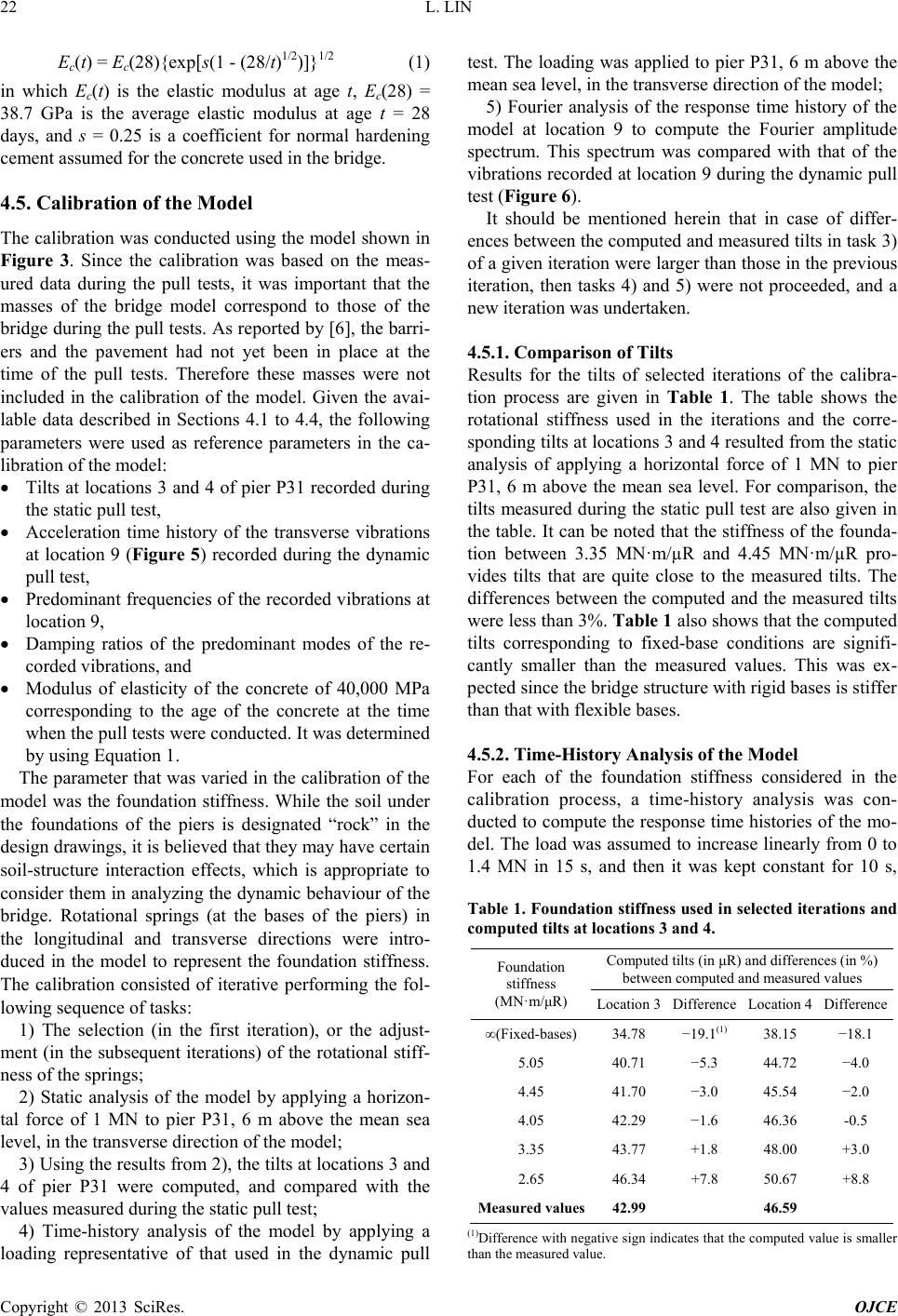
L. LIN
Copyright © 2013 SciRes. OJCE
Ec(t) = Ec(28){exp[s(1 - (28/t)1/2)]}1/2 (1)
in which Ec(t) is the elastic modulus at age t, Ec(28) =
38.7 GPa is the average elastic modulus at age t = 28
days, and s = 0.25 is a coefficient for normal hardening
cement assumed for the concrete used in the bridge.
4.5. Calibration of the Model
The calibration was conducted using the model shown in
Figure 3. Since the calibration was based on the meas-
ured data during the pull tests, it was important that the
masses of the bridge model correspond to those of the
bridge during the pull tests. As reported by [6], the barri-
ers and the pavement had not yet been in place at the
time of the pull tests. Therefore these masses were not
included in the calibration of the model. Given the avai-
lable data described in Sections 4.1 to 4.4, the following
parameters were used as reference parameters in the ca-
libration of the model:
• Tilts at locations 3 and 4 of pier P31 recorded during
the static pull test,
• Acceleration time history of the transverse vibrations
at location 9 (Figure 5) recorded during the dynamic
pull test,
• Predominant frequencies of the recorded vibrations at
locati on 9,
• Damping ratios of the predominant modes of the re-
corded vi br a t ions, and
• Modulus of elasticity of the concrete of 40,000 MPa
corresponding to the age of the concrete at the time
when the pull tests were conducted. It was determined
by using Equation 1.
The parameter that was varied in the calibration of the
model was the foundation stiffness. While the soil under
the foundations of the piers is designated “rock” in the
design drawings, it is believed that they may have certain
soil-structure interaction effects, which is appropriate to
consider them in analyzing the dynamic behaviour of the
bridge. Rotational springs (at the bases of the piers) in
the longitudinal and transverse directions were intro-
duced in the model to represent the foundation stiffness.
The calibration consisted of iterative performing the fol-
lowing sequence of tasks:
1) The selection (in the first iteration), or the adjust-
ment (in the subsequent iterations) of the rotation al stiff-
ness of the springs;
2) Static analysis of the model by applying a horizon-
tal force of 1 MN to pier P31, 6 m above the mean sea
level, in the transverse direction of the model;
3) Using the results from 2), the tilts at locations 3 and
4 of pier P31 were computed, and compared with the
values measured during the static pull test;
4) Time-history analysis of the model by applying a
loading representative of that used in the dynamic pull
test. The loading was applied to pier P31, 6 m above the
mean sea level, in the transverse direction of the model;
5) Fourier analysis of the response time history of the
model at location 9 to compute the Fourier amplitude
spectrum. This spectrum was compared with that of the
vibrations recorded at location 9 during the dynamic pull
test (Figure 6).
It should be mentioned herein that in case of differ-
ences between the computed and measured tilts in task 3)
of a given iteration were larger than those in the previous
iteration, then tasks 4) and 5) were not proceeded, and a
new itera t ion was undertake n.
4.5.1. C om parison of Tilts
Results for the tilts of selected iterations of the calibra-
tion process are given in Table 1. The table shows the
rotational stiffness used in the iterations and the corre-
sponding tilts at locations 3 and 4 resulted from the static
analysis of applying a horizontal force of 1 MN to pier
P31, 6 m above the mean sea level. For comparison, the
tilts measured during the static pull test are also given in
the table. It can be noted that the stiffness of the founda-
tion between 3.35 MN·m/µR and 4.45 MN·m/µR pro-
vides tilts that are quite close to the measured tilts. The
differences between the computed and the measured tilts
were less than 3%. Tabl e 1 also sho ws t hat the computed
tilts corresponding to fixed-base conditions are signifi-
cantly smaller than the measured values. This was ex-
pected since the bridge structure with rigid bases is stiffer
than that with flexible bases.
4.5.2. Time-History Analysis of the Model
For each of the foundation stiffness considered in the
calibration process, a time-history analysis was con-
ducted to compute the response time histories of the mo-
del. The load was assumed to increase linearly from 0 to
1.4 MN in 15 s, and then it was kept constant for 10 s,
Table 1. Foundation stiffness used in selected iterations and
computed tilts at locations 3 and 4.
Foundation
stiffness
(MN·m/μR)
Computed tilts (in μR) and differences (in %)
between computed and measured values
Location 3 Difference Location 4 Difference
∞(Fixed-bases) 34.78 −19.1(1) 38.15 −18.1
5.05 40.71 −5.3 44.72 −4.0
4.45 41.70 −3.0 45.54 −2.0
4.05 42.29 −1.6 46.36 -0.5
3.35 43.77 +1.8 48.00 +3.0
2.65 46.34 +7.8 50.67 +8.8
Measured values 42.99 46.59
(1)Difference wi th negat ive sig n indicates t hat the co mputed v alue is small er
than the measured value.